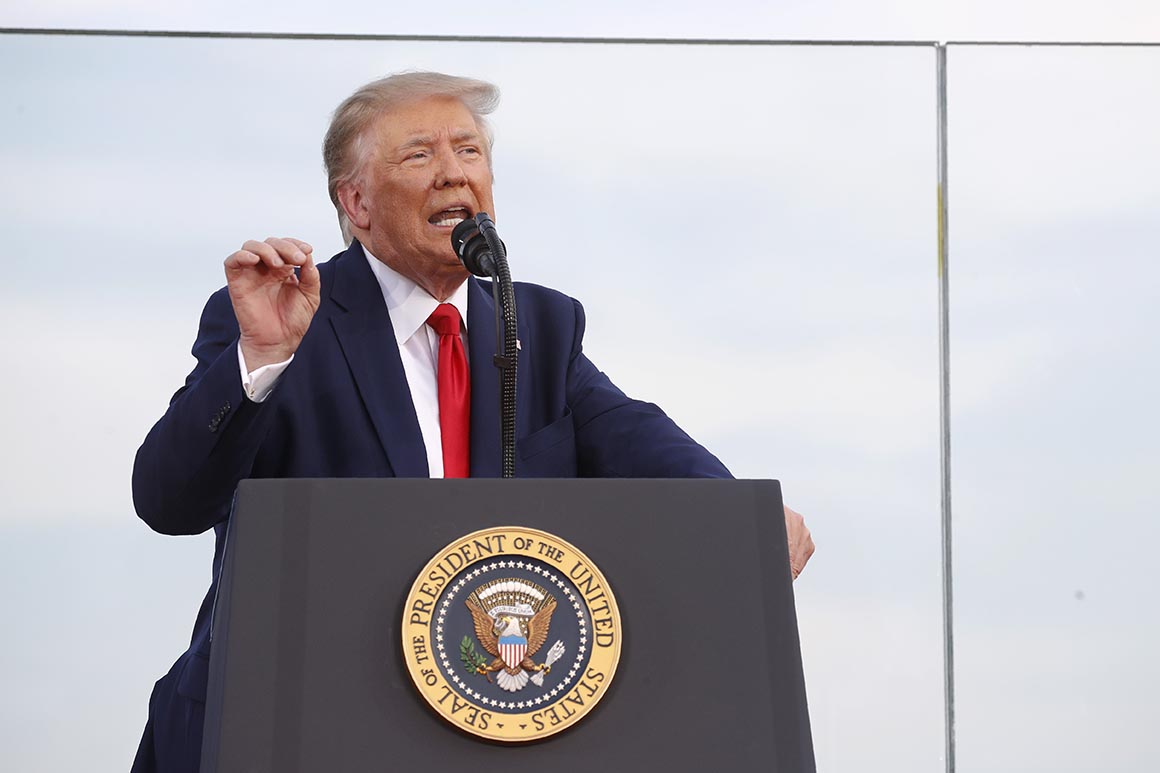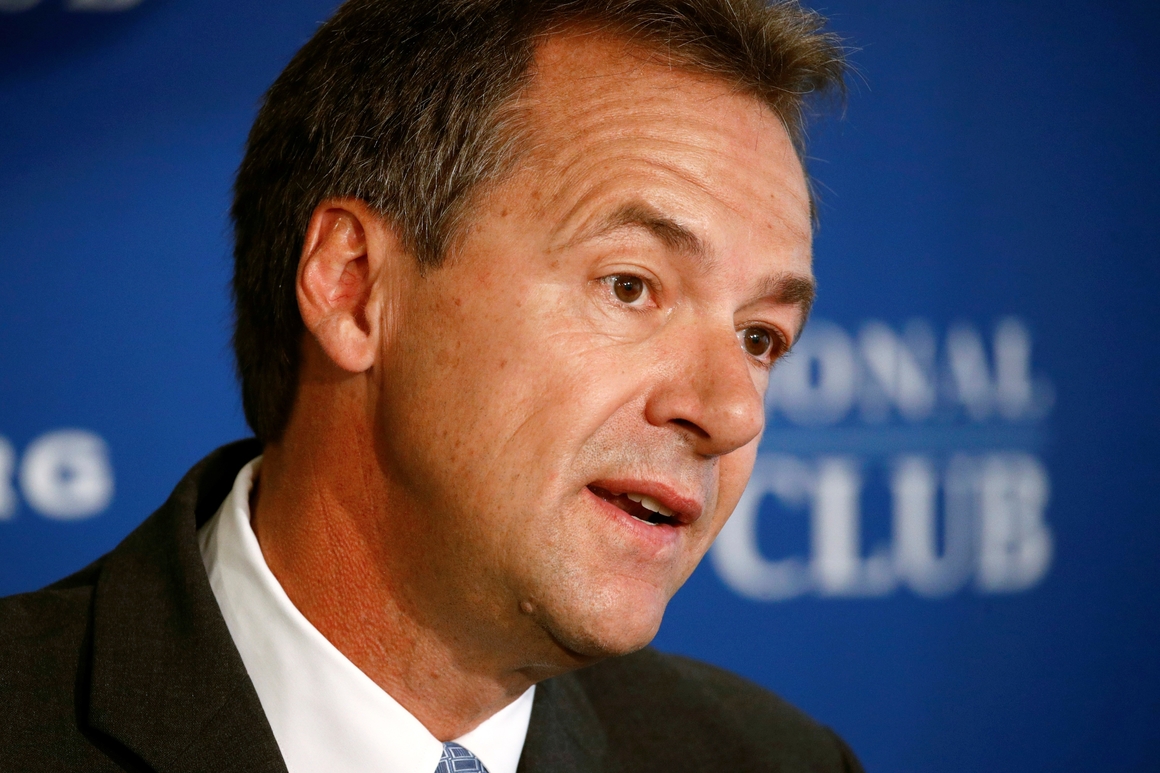
President Donald Trump is now an underdog to win a second term, and Republicans’ Senate majority is in serious danger of being swept out with him, according to the latest edition of POLITICO’s Election Forecast.
A series of crises over the past three months has seen the political environment deteriorate markedly for Trump and his party. The percentage of voters who think the country is headed in the wrong direction is hitting new highs — a record 75 percent in the latest POLITICO/Morning Consult poll — and Trump’s approval rating is settling near his all-time lows.
Meanwhile, Joe Biden’s lead over Trump is swelling to roughly 10 points nationally — and for the first time, our forecast classifies Biden as the clear favorite in the race.
The national atmosphere is toxic enough that Senate Republicans, who currently hold a three-seat majority, no longer have a significant edge in their quest to retain control of the chamber next year. Democrats have both built leads in states that were previously considered up-for-grabs and put new states firmly on the map, expanding their path to a majority and potential unified control of government in 2021.
POLITICO’s Election Forecast is a long-term, qualitative examination of the political landscape, from the presidential campaign down to the congressional-district level. It is based on continual interviews with strategists and operatives, polling and other data streams and the electoral and demographic trends driving the 2020 campaign. It is a more deliberative approach than a statistical model, which can be helpful in cutting through polls and other data sources but can also shift from day-to-day with little rationale for the changes.
From the early weeks of the coronavirus pandemic, Trump’s standing with voters has suffered, with a majority disapproving of his handling of the emergency. But with Americans more dissatisfied than ever after four months since the coronavirus became a dominant force in the country — and with the same period of time to go until Election Day — the shift toward Democrats is both real and durable, though it’s not irreversible.
The signs are apparent: Trump’s campaign is running ads in states he won handily in 2016, like Georgia and Ohio. Senate Republicans aren’t just playing defense in vulnerable seats in states like Colorado, Maine and North Carolina — they’re also retrenching in places like Iowa and Montana.
Meanwhile, Trump’s incumbent advantages — money and the bully pulpit of the presidency — are eroding. Biden’s fundraising has surpassed Trump’s over the past two months, though Trump’s campaign retains a cash-on-hand edge. Trump’s poll numbers on the coronavirus and the civil unrest regarding racial injustice are consistently underwater, suggesting Americans believe he has failed to lead on the two dominant issues facing the country.
It could all add up to a potentially disastrous November for Republicans up and down the ballot if the president’s numbers don’t recover. There is still time for that to happen — and a plausible path for Trump to win an Electoral College majority and the GOP to keep the Senate. But it has grown much less likely.
Electoral College
The most consequential changes to the forecast are four one-time toss up states moving to “Lean Democratic”: Michigan, Nevada, New Hampshire and Pennsylvania. Adding those four to Biden’s column, along with bluer states, would put the Democrat at 268 electoral votes, just shy of the majority needed to clinch the presidency.
Michigan and Pennsylvania are the second- and fourth-largest states Trump flipped to the Republican column in 2016 — and along with Wisconsin, which remains as a toss up, they have been at the heart of Democrats’ strategy to win back the presidency. Biden had double-digit leads in all three states in the most recent high-quality polls, from The New York Times and Siena College — but most observers see Wisconsin as the most Republican-friendly of the three.
Nevada and New Hampshire were states Hillary Clinton carried in 2016 — and with Biden posting larger leads against Trump, they have moved further from the president’s grasp.
The states remaining in the toss up column are Arizona, Florida, North Carolina and Wisconsin, along with two competitive congressional districts in Maine and Nebraska, where electoral votes are split by district. In each of those places, recent public and private polling has showed Biden leading Trump, though it’s too early to say the Democrat is a significant favorite.
Meanwhile, as Biden’s lead over Trump has increased over the past few months, the list of battlegrounds has expanded. Trump’s campaign is now spending significant resources in states the president carried comfortably in 2016: Georgia, Iowa and Ohio.
All three are still classified as “Lean Republican” in POLITICO’s forecast, as polling shows the two candidates neck-and-neck, even with Biden opening up a sizable national lead. If they are toss-up states on Election Day, it would essentially foreclose Trump’s path to a second term.
Trump’s advertising spend also includes small buys in Minnesota and New Mexico, two states Clinton carried. Minnesota remains classified as Lean Democratic; it’s not difficult to imagine Trump winning it if his national standing improves. New Mexico is rated as Likely Democratic.
Senate
Republicans entered the 2020 Senate election cycle with greater exposure — including special elections, they control 23 of the 35 seats on the ballot this fall — but with some significant advantages. The GOP holds a three-seat majority, but only two of the GOP-held seats up this year are in states Clinton carried in 2016. Meanwhile, there are also two Democratic senators from Trump states up for reelection.
But the race for Senate control is now close to a coin flip. Democrats now have discernible leads in Arizona and Colorado. Retired astronaut Mark Kelly has consistently outpolled appointed Sen. Martha McSally in Arizona’s special election.
After winning last week’s Democratic primary in Colorado, former Gov. John Hickenlooper begins with a lead over GOP Sen. Cory Gardner. Gardner is a skilled politician, but he’s running in a state where Trump won only 43 percent of the vote in 2016. While the forecast is currently leaving the race in the toss-up column, Gardner is in extreme peril.

In Iowa, GOP Sen. Joni Ernst is no longer a significant favorite to win a second term. A Des Moines Register/Mediacom poll last month showed her narrowly trailing Democratic nominee Theresa Greenfield, and the race is now a toss-up.
Also joining the toss-up ranks is Republican-leaning Montana. Democratic Gov. Steve Bullock has earned high marks for his handling of the pandemic, and even polls that show Trump with a solid lead in the state have Bullock leading or tied with GOP Sen. Steve Daines.
With one toss up race moving slightly into the Democratic column, and two GOP-leaning states nudging to the highly competitive toss up rating, Republicans currently hold or are favored to win 48 seats, only one more than Democrats. The majority is at stake in the five toss-up races: Colorado, Iowa, Maine, Montana and North Carolina.
House
As the national environment has swung toward Democrats, their grip on the House has strengthened. The latest ratings have 216 seats in the Democratic column, only two shy of the majority.
Democrats’ online-powered fundraising machine has enabled the party to raise money at a rapid clip, seemingly unencumbered by the nation’s economic slowdown. As a result, a number of once-vulnerable freshman House Democrats — including Katie Porter and Josh Harder in California — are far more secure than when the election cycle began.
Republicans would have to run the table in the toss-up races — as they did in May’s special election for a suburban Los Angeles seat. Now-Rep. Mike Garcia’s better than expected performance in that special had some Republicans crowing about their chances to win back the House.
But given Democratic voters’ enthusiasm to turn out in November against Trump, a significant realignment of the current political dynamic will be necessary to put Democrats’ majority seriously at risk.
Governors
Given the unprecedented challenges of the pandemic, governor’s races are more likely to be influenced by in-state dynamics than national factors. That’s the case in Vermont, where GOP Gov. Phil Scott’s announcement that he will seek another term in Montpelier makes him favored to win, despite the state’s orientation in federal elections.
In North Carolina, the most populous state holding a gubernatorial election this year, Democratic Gov. Roy Cooper has pushed out to a sizable lead in the polls over GOP Lt. Gov. Dan Forest — and the race is now leaning Democratic.
Source: politico.com
See more here: news365.stream






